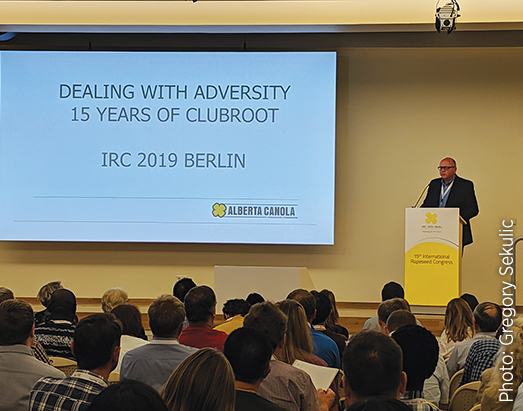I dream of being able to grow it in 15 years

By Ward Toma
“I dream of being able to grow it in 15 years.”
A wishful statement, not expressed by a wide-eyed farmer seeing a new crop with incredible potential, but instead by a farmer that has serious doubts about his ability to continue to grow this incredible crop. Hubertus Paetow, president of the German Agricultural Society, in his welcoming remarks to the nearly 900 attendees of the 2019 International Rapeseed Congress this past June in Berlin, spoke of the challenges of farming in modern Germany. His dream was one of still being able to grow canola on his farm in Germany in 15 years down the road. Research keeps his dream alive.
I was attending the International Rapeseed Congress, having been invited to present a review on the status of clubroot in North America at a pre-conference workshop. After the EU and China, at just under 100 attendees, Canada had the third largest contingent of researchers, agronomists, extension agents and students attending the largest gathering of the greatest minds in canola research worldwide. While clubroot is endemic throughout most of the canola growing region in Europe, it is easily kept at bay with rotations. A larger number of economically viable cropping options allows for this and clubroot only becomes a problem when volunteers and susceptible weeds are not controlled.
While Europe has a relatively easy solution for clubroot, the same cannot be said for insects or plant diseases. Long rotations are not stopping the devastation of canola crops by the pollen and flea beetles. Just like in Canada, diseases such as blackleg, sclerotinia and fusarium can severely impact production. Unfortunately, it appears the largest force behind the growing appearance of these insects and diseases is the consumer.
Germany is one of the top four agricultural producing member countries of the EU; over half of the country is farmland. It is a major producer of fresh vegetables, cereals, and rapeseed (they just cannot bring themselves to call it canola!), as well as meat and dairy. A quick stop at a Berlin grocery store confirms this: fresh and locally made products are high quality, diverse and plentiful. However, as large as agriculture is, it represents under one percent of gross domestic product. Just over one percent of the German workforce is employed directly in agriculture. And while these numbers are somewhat larger in some other EU member states, it quickly becomes apparent that agriculture is not in charge of its own future. This is further supported by the fact that most financial support for agriculture in the EU is delivered through environmental budgets for ecological services such as land set aside and wildlife habitat.
We in Canadian agriculture still take pride in the role we played in feeding Europe after the devastation of the Second World War. But in Europe, recent generations are concerned about more than the availability of food. Various failures and scandals by governments, regulatory agencies and large companies have reduced the general sense of trust amongst consumers that the right thing is being done by those in agriculture to protect their food and the environment it is produced in. This sense of distrust has been extended to the research that developed the tools farmers use to manage pests. More than a few EU researchers at the International Rapeseed Congress began their presentations expressing frustration because the solution often put forward by their governments, and farmers like Hubertus Paetow, is research.
This was very apparent in the presentations and poster sessions at the Congress. Leading edge research in certain areas is not being done by EU research institutions as modern biotech tools are not available to them. Groundbreaking work in biotech was increasingly presented by Chinese, Australian and Canadian researchers, with some EU scientists watching wistfully from the audience. However, while their research toolbox has shrunk, it has not been emptied.
| TOTAL | $6,515,435.91 | $40,745,379.60 |
| Project Title | Alberta Canola’s Active Projects | Total project $ |
|---|---|---|
| Agronomy | $1,123,537.99 | $4,523,808.60 |
| Genetics | $462,932.83 | $1,939,863.00 |
| Insects | $1,073,845.42 | $3,808,051.00 |
| New Product Development | $886,081.00 | $2,085,157.00 |
| Pathology | $1,938,896.67 | $8,288,500.00 |
| Canadian AgriScience Canola Cluster – 25 projects over 5 years | $1,030,142.00 | $20,100,000.00 |
The greatest outcome of events like the International Rapeseed Congress is that in bringing together scientists from around the world, from vastly different climates, geographic and political realities, different points of view and ideas are shared. More than a few conversations took place in which phrase “now that is an interesting idea” was uttered, and a new line of research subsequently pursued. My colleagues from Canada and I, along with the attendees left the Congress less frustrated and with a renewed sense of hope.
KEEP UP TO DATE. Receive the latest news, media releases and daily
grain prices when you subscribe to the Alberta Canola Connections Newsletter. Visit albertacanola.com/subscribe today.





